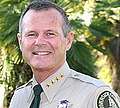Riverside County Sheriff's Department
The Riverside County Sheriff's Department (RCSD or RSD), also known as the Riverside Sheriff's Office (RSO), is a law enforcement agency in Riverside County, in the U.S. state of California. Overseen by an elected sheriff-coroner, the department serves unincorporated areas of Riverside County as well as some of the incorporated cities in the county by contract (see contract city). 17 of the county's 26 cities, with populations ranging from 4,958 to 193,365, contract with the department for police services. The county hospital and one tribal community also contract with the department for proactive policing. Riverside County is home to 12 federally recognized Indian reservations. Absent proactive policing and traffic enforcement, the department is responsible for enforcing criminal law on all Native American tribal land within the county. This function is mandated by Public Law 280, enacted in 1953, which transferred the responsibility of criminal law enforcement on tribal land from the federal government to specified state governments including California. The department also operates the county's jail system.
| Riverside County Sheriff's Department | |
|---|---|
 | |
 | |
 Flag of Riverside County | |
| Common name | Riverside Sheriff's Office |
| Abbreviation | RCSD, RSD, RSO, RCSO |
| Agency overview | |
| Formed | May 9, 1893 |
| Employees | 3000+ |
| Annual budget | $502 million |
| Jurisdictional structure | |
| Operations jurisdiction | Riverside County, California, U.S. |
 | |
| Map of Riverside County Sheriff's Department's jurisdiction. | |
| Operational structure | |
| Headquarters | Riverside, California |
| Sheriff-Coroner responsible |
|
| Bureaus | 4
|
| Divisions | 10
|
| Facilities | |
| Stations | 12 |
| Jails | 5
|
| Website | |
| www.RiversideSheriff.org | |
In addition to performing law enforcement and corrections roles, the department performs the functions of the coroner's office and marshal's office. In its coroner function, the department is responsible for recovering deceased persons within the county and conducting autopsies. When California reorganized its judicial system in the early 21st century and eliminated state marshal's offices, the department assumed responsibility for state courts within the county, providing court security and service of warrants and court processes. The department also provides services such as air support, special weapons teams for high risk critical incidents, forensics services and crime laboratories, homicide investigations, and academy training to smaller law enforcement agencies within the county and in surrounding counties.
History

Riverside County was created from portions of San Bernardino and San Diego Counties on May 9, 1893. In the early history of the county, the sheriff's office was a one-person operation. As the county grew in population, so too did the department, eventually transforming into a modern full-service law enforcement agency.
The department made national headlines on May 9, 1980, when five men armed with shotguns, an assault rifle, handguns, and an improvised explosive device robbed the Norco branch of Security Pacific Bank. Since dubbed the "Norco shootout", deputies responding to the bank robbery call, armed only with their pistols, confronted the perpetrators outside the bank and a prolonged gun battle and subsequent vehicle pursuit ensued. The aftermath of the incident left 33 patrol cars damaged or completely destroyed, one sheriff's helicopter shot down, three robbers imprisoned for life, two robbers dead, eight sheriff's deputies wounded, and one deputy killed in the line of duty.[1]
Today the Riverside County Sheriff's Department is responsible for 7,303 square miles, spreading almost 200 miles in length, and embracing approximately 50 miles in width.[2] This territory constitutes the fourth largest county in the state of California and is roughly the size of the state of New Jersey in total area. Vast changes have occurred in Riverside County since its inception. The population, having increased from 13,745 in 1893, to more than 2,189,641 in 2010, ranks it fourth in population among California's counties behind Los Angeles, Orange, and San Diego Counties respectively.[3] Expanding to keep up with the county's explosive growth, the Riverside County Sheriff's Department is now the second-largest sheriff's department and third largest police agency in California, with a staff of over 3,600.[4][5]
County jail system
The Riverside County Sheriff's Department operates the county's jail system. The Riverside County jails provide short-term and long-term (depending on the type of sentencing) incarceration services for the county, jailing subjects arrested and charged with various types of crimes pending their court disposition as well as those convicted of crimes and sentenced. Services also include transportation of prisoners if necessary related to court appearances, and transferring prisoners between jurisdictions such as other counties, states, or the California Department of Corrections and Rehabilitation. Jails are staffed by fully sworn deputy sheriffs as well as specialized correctional deputies. The county's jail system consists of the Robert Presley Detention Center (RPDC)[6] in downtown Riverside,[7] the Southwest Detention Center (SWDC) in French Valley near Murrieta, the Larry Smith Correctional Facility (SCF) in Banning, the Indio Jail, and the Blythe Jail.
The Riverside County Jail (RCJ) was renamed RPDC in 1989[8] with the completion of a new, modern jail facility across the street from the original jail. The "Old Jail" was originally constructed in 1933 and was built as part of the old historic courthouse annex. In 1963, an addition was made to the jail, which included dormitory style housing units, a dispensary, detox cell, segregation cells, visiting area, and business office. In 1979, the county expanded the female section of the jail. The "Old Jail" was closed in 2011.
The Indio Jail facility is being completely rebuilt, with the old Indio Jail being demolished and turned into a parking lot upon completion of construction. The new Indio Jail will be the largest correctional facility in Riverside County, with the ability to house 1,626 beds. Construction began in March 2014 and is anticipated to be completed at the end of 2016, the facility be fully operational near the end of 2017.
| Name[9] | Location |
|---|---|
| Blythe Jail | Blythe, California |
| Cois M. Byrd Detention Center | Murrieta, California |
| John J. Benoit Detention Center | Indio, California |
| Larry D. Smith Correctional Facility | Banning, California |
| Robert Presley Detention Center | Riverside, California |
Academy
The Riverside Sheriff's Academy is located at the Ben Clark Public Safety Training Center (BCTC) near the March Air Reserve Base. Sheriff's academy training at BCTC is standardized and certified by the California Commission on Peace Officer Standards and Training (POST). Trainees receive a minimum of 24 weeks of intensive training.[10] The county's municipal police departments as well as other regional law enforcement agencies utilize the department's academy to train their cadets/trainees as well. Upon successful completion of the academy, graduating Riverside County Deputy Sheriff Trainees also receive additional detention-specific training at the academy if they will be going to a jail posting for their first assignment (regardless of first assignment, all Sheriff's Deputies must eventually go to patrol if they wish to advance in rank/special assignment).
BCTC is also the location of the sheriff's corrections and dispatch academies.[11][12] In addition, BCTC provides ongoing advanced career training for the department and surrounding agencies.[13]
BCTC is a public safety training center jointly operated by the Riverside County Sheriff's Department and the Riverside County Fire Department in cooperation with the California Department of Forestry and Fire Protection, the California State Fire Marshal, the California Highway Patrol, and Riverside Community College.
Controversies
Undercover High School Stings
The Riverside Sheriff's Department conducted an undercover sting operation targeting students at Chaparral High School. Operation Glasshouse was granted permission by Superintendent Timothy Ritter. The Riverside Sheriff's Department was accused of ignoring affluent students and choosing targets that belonged to minority groups and the mentally disabled.[14][15]
Fraudulent Promotion Exams
An internal investigation by the Riverside County Sheriff's Department revealed that 25 employees cheated on a promotional exam. No employees go fired, and some were promoted. [16]
Contract cities served
- Calimesa
- Canyon Lake
- Coachella
- Eastvale
- Indian Wells
- Jurupa Valley
- La Quinta
- Lake Elsinore
- Moreno Valley
- Norco
- Palm Desert
- Perris
- Rancho Mirage
- San Jacinto
- Temecula
- Wildomar
Also serves the Riverside County Regional Medical Center (contract fulfilled through the Moreno Valley Station), the Morongo Indian Reservation (contract fulfilled through the Cabazon Station), and the De Luz Community Services District (contract fulfilled through the Southwest Station).
Current and past sheriffs
| #[17] | Portrait | Name | Term in office | Length of Service | Previous office |
|---|---|---|---|---|---|
| 1 | No image available |
Fred Swope (1893-1895) |
1893 – 1895 |
2 years | |
| 2 | No image available |
W.B. Johnson (1895-1899) |
1895 – 1899 |
4 years | |
| 3 | No image available |
P.M. Coburn (1899-1907) |
1899 – 1907 |
8 years | |
| 4 | No image available |
Frank Wilson (1907-1923) |
1907 – 1923 |
16 years | |
| 5 | No image available |
Sam Ryan (1923-1924) |
1923 – 1924 |
1 year | |
| 6 | No image available |
Clemens Sweeters (1924-1931) |
1924 – 1931 |
7 years | |
| 7 | No image available |
Carl Rayburn (1931-1952) |
1931 – 1952 |
21 years | |
| 8 | No image available |
Joe Rice (1952-1963) |
1952 – 1963 |
11 years | |
| 9 | No image available |
Bernard Clark (1963-1986) |
1963 – 1986 |
23 years | |
| 10 | No image available |
Cois Byrd (1986-1994) |
1986 – 1994 |
8 years | |
| 11 | No image available |
Larry Smith (1994-2002) |
1994 – 2002 |
8 years | |
| 12 | No image available |
Bob Doyle (2003-2007) |
2003 – 2007 |
4 years | |
| 13 |  |
Stanley Sniff (2007-2019) |
2007 – 2019 |
12 years | |
| 14 |  |
Chad Bianco (2019-) |
2019 – Incumbent |
1 year | Sheriff's Lieutenant |
Organizational structure
The following represents the organization of the RCSD:[18][19]
Bureaus
- Coroner & Courts
- Corrections
- Field Operations
- Support & Administration
Ranking structure and insignias
| Title | Insignia | |
|---|---|---|
| Sheriff | ||
| Undersheriff | ||
| Assistant Sheriff | ||
| Chief Deputy | ||
| Captain | ||
| Lieutenant | ||
| Sergeant | ||
| Master Investigator | Two stripes over two rockers, with a star encircled by a wreath in between. | |
| Investigator | There are four ranks as part of the Career Investigator Program: Investigator I, Investigator II (Senior Investigator), Investigator III (Lead Investigator), and Investigator IV (Master Investigator). | |
| Corporal | There is only one rank as a Corporal: Corporal I. A Corporal's role is to assist mainly the Sergeant and/or the Lieutenant with overseeing of Probationary Deputies and other Deputies in that division. When a member of the Riverside County Sheriff is promoted to Corporal he/she receives a new uniform with a Corporal Insignia placed on the upper left and right arm underneath the Riverside County Sheriff emblem/insignia. | |
| Deputy Sheriff | No Insignia | There are three Deputy Sheriff grades (currently used only for pay grade identification): Deputy Sheriff, Deputy Sheriff A (possesses CA intermediate POST certificate), and Deputy Sheriff B (possesses CA advanced POST certificate). Deputy Sheriff's distinguish themselves from Correctional Deputies and Deputy Coroners by having a yellow stripe down the side of their pants. Correctional Deputies and Deputy Coroners also wear a black tie while Deputy Sheriffs wear a green tie. |
Divisions
- Administrative Services
- Coroner & Courts
- Corrections
- East Field Operations
- Professional Standards
- Public Information Office
- Special Operations
- Support Services
- West Field Operations
Stations
- Cabazon Station (serves the city of Calimesa, the unincorporated communities of Cabazon, Cherry Valley, Whitewater, and the Morongo Indian Reservation)
- Colorado River Station (serves unincorporated territory outside the city of Blythe)
- Hemet Station (serves the city of San Jacinto, the unincorporated communities of Anza, Aguanga, East Hemet, Cahuilla, Fern Valley, Homeland, Idyllwild, Mountain Center, Nuevo, Pine Cove, Pinyon Pines, Sage, Valle Vista, and Winchester, and Anza Borrego State Park, Mt. San Jacinto Community College, and the Santa Rosa Wilderness)
- Thermal Station (serves the cities of La Quinta and Coachella and the unincorporated areas of Thermal, Mecca, Indio Hills, North Shore, and Bermuda Dunes)
- Jurupa Valley Station (serves the cities of Jurupa Valley, Eastvale, and Norco)
- Lake Elsinore Station (serves the cities of Wildomar, Canyon Lake, and Lake Elsinore)
- Moreno Valley Station (serves the city of Moreno Valley)
- Palm Desert Station (serves the cities of Indian Wells, Rancho Mirage and Palm Desert)
- Perris Station (serves the city of Perris)
- Southwest Station (serves the city of Temecula and the unincorporated communities of French Valley and De Luz)
Other facilities
- Aviation
- Coroner/Public Administrator
- Ben Clark Training Center
- Dispatch Center
- Sheriff's Administration
- Special Investigations Bureau
- Courts/County Administration Building
- College of the Desert Public Safety Academy
References
- "Norco Bank Robbery".
- "2010 Census Gazetteer Files". United States Census Bureau. August 22, 2012. Retrieved September 15, 2014.
- Bureau, U. S. Census. "U.S. Census website". United States Census Bureau. Retrieved 2019-07-05.
- ":: Sheriff-Coroner :: Riverside County, California". www.riversidesheriff.org.
- "Riverside County Sheriff's Department Recruitment".
- Named for former State Senator Robert B. Presley (D-Riverside)
- RPDC info; Also see: 33.9790°N 117.3745°W
- "JoinCalifornia - Robert B. Presley". www.joincalifornia.com.
- "Riverside County Sheriff's Department-History".
- "Clark Training Center - Law Enforcement & Public Safety Training". www.clarktraining.org.
- "Clark Training Center - Law Enforcement & Public Safety Training". www.clarktraining.org.
- "Clark Training Center - Law Enforcement & Public Safety Training". www.clarktraining.org.
- "Clark Training Center - Law Enforcement & Public Safety Training". www.clarktraining.org.
- VICE (2014-07-16), Undercover Cop Tricks Autistic Student into Selling Him Weed (Full Length), retrieved 2016-05-27
- "The Entrapment of Jesse Snodgrass". Rolling Stone. 2014-02-26. Retrieved 2016-05-27.
- Kelman, Brett. "Twenty-five cops were caught cheating on a promotional exam. Nobody were fired. Some still got promoted". Retrieved 26 January 2020.
- "Riverside County Sheriff's Department-History".
- "Riverside County Sheriff's Department-Executive Staff".
- "Riverside County Sheriff's Department-Directory".